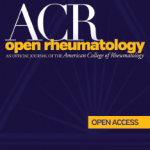
rvlsoft / shutterstock.com
The ACR will add a new professional journal, ACR Open Rheumatology, in January 2019. An open access journal, it will feature the same high-quality, rigorously peer-reviewed articles on original investigations in rheumatology research, as well as commentaries and reviews, as the ACR’s other journals, Arthritis & Rheumatology (A&R) and Arthritis Care & Research (AC&R).
Co-Editors-in-Chief Edward H. Yelin, PhD, and Patricia P. Katz, PhD, are both professors of medicine at the University of California, San Francisco (UCSF). Drs. Yelin and Katz previously served in the same role for AC&R from 2006–11, “so we have a long history with the ACR’s journals and a strong commitment to making the journals successful,” says Dr. Katz.
ACR Open Rheumatology’s deputy editor for clinical science is David Daikh, MD, PhD, director of the Rheumatology Fellowship Training Program at UCSF and chief of rheumatology for the San Francisco VA Medical Center. The new journal’s deputy editor for basic science is Bruce N. Cronstein, MD, the Dr. Paul M. Esserman Professor of Medicine at New York University.
Accessible for Reading & Sharing
What makes ACR Open Rheumatology different? As its title suggests, the new journal will follow an accessible, open access model, says Jane Diamond, managing editor of A&R and senior director, ACR journal publications.

Dr. Cronstein
“Anyone will be able to go online and read the articles,” as well as download or share them with others, says Ms. Diamond. Most articles in both A&R and AC&R are openly accessible only one year after publication. Before that, only ACR members and subscribers may view them in full, except for a minority of articles where a different option has been chosen by the authors. “All articles in ACR Open Rheumatology will be free immediately upon publication for anyone to read, pull out figures or tables, share, publish or reuse anywhere for noncommercial purposes without having to request copyright permission,” she explains.
If their articles are accepted to ACR Open Rheumatology, authors will pay an article publication charge of $2,500, with a discounted charge ($2,000) for ACR member authors. These charges help fund the publication, which has no paid subscriptions. Some foundations and other funders cover article publication charges in their research grants to authors, she notes. For accepted articles submitted during the first six months the submission site is open (i.e., from October 2018 through March 2019), the article publication charge will be waived.

Dr. Daikh
Authors may submit articles directly to ACR Open Rheumatology, but in addition, authors whose articles were submitted to A&R or AC&R and just missed the threshold for acceptance but were still viewed by the editor as being of scientific value will be invited to have their articles internally resubmitted to the new journal. In most cases, the reviews from A&R or AC&R will be used, expediting the time between submission and decision.
ACR Open Rheumatology will be published by John Wiley & Sons. After the first 25 articles are published, the journal will be submitted for indexing by PubMed, says Ms. Diamond. The website for the new journal is www.acropenrheum.org.
Q&A with the Co-Editors-in-Chief
Drs. Katz and Yelin share their thoughts on the benefits of ACR Open Rheumatology to the ACR, researchers and readers with The Rheumatologist:
TR: What was the idea behind the creation of ACR Open Rheumatology? Why is it beneficial for the ACR to have an open access journal along with its traditional-
format journals?

Dr. Yelin
Dr. Yelin: “ACR Open Rheumatology solves several problems in the peer-reviewed literature. The most important one isn’t directly related to the ‘open access’ vs. subscription model. Instead, it deals with the fact that the ACR’s two existing journals do not have the space to publish all the meritorious submissions they receive. The ACR can now provide more space for publishing. With open access, in fact, there is no limit to the number of meritorious manuscripts that can be published. With acceptance rates at A&R and AC&R so low, we estimate that there is at least another quintile of submissions that tough peer review would suggest deserve to see the light of day. ACR Open Rheumatology will provide the opportunity of publication to the authors of these submissions and, to the ACR, the opportunity to keep the submissions within its publishing house.”

Dr. Katz
Dr. Katz: “There is a trend among some funding entities, particularly in Europe, to require publication in open access journals—not just open access articles within traditional journals, but publication in completely open access journals. We hope that ACROR will be an attractive option to authors with these requirements.”
TR: What will make the journal unique and more open to potential authors, including rheumatologists and experts from other subspecialties?
Dr. Yelin: “ACR Open Rheumatology is designed to be more open in more than just how the publication is financed. There has always been some overlap between the topics and methodologies covered by A&R and AC&R. However, the new journal is, by design, intended to cover all areas within rheumatology and about the diseases subsumed by this subspecialty. This enables us to make sure the differing perspectives of authors—and readers—across areas of inquiry will be reflected in each issue. We are also intending to be open to explicitly cross-disciplinary work. A lot of very important work crosses fields of inquiry, for example, epigenetics and big data science.
“Finally, because we previously served in the same role in AC&R, we will try to replicate one of the successful initiatives of our tenure at that journal by explicitly stoking fields of inquiry by soliciting manuscripts for themed issues in important new areas. As research delves into the common basic mechanisms underlying many diseases related to inflammation, there will no doubt be opportunities to explore the implication for such issues, for example, as the appropriate care model for systemic lupus erythematosus, which may affect multiple organ systems traditionally within the purview of diverse specialties.”
TR: What type of articles do you hope to publish?
Dr. Yelin: “There are no limits to the kinds of inquiry we hope to publish nor to the methodologies used in the research. However, given that we will explicitly cover the entire range of areas subsumed by both A&R and AC&R, we will be especially open to manuscripts that push the boundaries among disciplines within rheumatology research and to topic areas that do the same. The bottom line is the same as the existing journals: innovation, rigor and relevance.”
Dr. Katz: “One specific advantage that ACR Open Rheumatology will have is that limits on article length and number of tables can be less stringent. This may be particularly attractive to investigators who would like to display additional tables or figures, or who have very complex methods that need more extensive descriptions. Because of the broad range of topics, from basic science through health services research, we would especially like to encourage submissions from multidisciplinary research groups—topics that perhaps don’t fit cleanly into the purview of either A&R or AC&R, but are relevant to rheumatology.”
TR: How do you envision working together, along with your team of deputy editors?
Dr. Yelin: “No two editors cover the areas of inquiry relevant to ACR’s membership. We ourselves know best the methods of epidemiology, health services research, behavioral science and public policy. Our deputy editors, Drs. Daikh and Cronstein, cover basic and translational sciences and clinical care. They will be responsible for handling manuscripts in those areas. We will work together to ensure submissions that cross disciplines are welcome and handled with the same rigor of peer review that those within our areas of expertise receive. One nice feature of open access journals is that once we—or they—make decisions about the merit of manuscripts, there is no limit to the number that can be published.”
After the first 25 articles are published, the journal will be submitted for indexing by PubMed, says Ms. Diamond.
Complementary Collaboration
Dr. Katz: “Ed and I have a long history with ACR’s journals and a strong commitment to making the journals successful. We are both PhD scientists who have spent much of our careers working in rheumatology. Ed has done groundbreaking research in work disability, and focuses on social, policy and health services/health economics research. My background is rather eclectic, and my research tends to focus on development and use of patient-reported outcomes, psychological well-being and depression, and the impact of lifestyle factors, such as obesity, physical activity and sleep, on disease outcomes.”
Bottom Line
The new ACR Open Rheumatology journal will offer the rheumatology community the opportunity to read more research on wider topic areas with the assurance that the studies have undergone stringent peer review, and more researchers will be able to share their work than ever before. Look for the premiere issue in January.
Susan Bernstein is a freelance journalist based in Atlanta.


